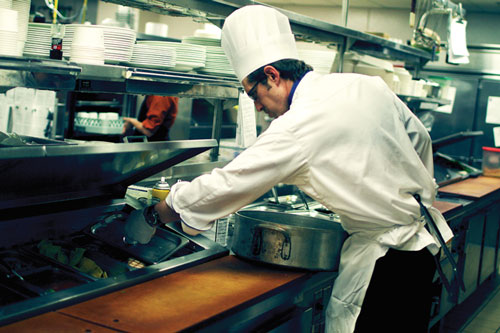Why I Love Bad Hospital Food

Photograph by Noah Stephens.
I have spent more time in hospitals than someone who is young and healthy ought to. When I was seventeen, my best friend was paralyzed in an athletic accident and a close family member was diagnosed with cancer. (My father died many years ago, though I was too young to remember those hospital visits.) Because I was a pretentious teenager I even recorded a concept album about hospitals for a high-school English project. And when I think about hospitals, I always think about hospital food.
In Maisonneuve's current issue, Monica Kidd writes about efforts to improve food in health care institutions, which have lagged behind the larger local-and-organic movement. Hospital food is famously awful; it conjures up images of, as Kidd writes, "chicken base in water, green Jell-O, applesauce." This despite hospitals' ostensible duty to heal us, to make us better. Doctors cut tumours from our bodies and repair our shattered vertebrae, and then they feed us sodium water and ground horse hooves.
The truth, though, is that I love bad food in hospitals. Not "hospital food" in the tray-of-mush recovering-patient sense, but the sort of sickening, lukewarm fare you can gorge on at any institutional cafeteria: greasy fries, stale coffee, vending-machine candy, pizza. So much cold pizza. I love hospital food because hospitals are stressful and food is comforting, especially food with lots of sugar and salt and fat, which is to say the most delicious and destructive food of all. They ease the anxiety of the hospital by getting me high on my brain's own dopamine.
My relationship with food and hospitals is by now Pavlovian. Last year I brought my partner to the ER for a minor medical problem and all I wanted to do was eat. I daydreamed about potato chips. I imagined a Styrofoam cup of coffee in my hand. (Coffee to go, along with long hot showers, is something that no amount of going-green rhetoric will ever convince me to give up.) I wasn't hungry but I wanted food. I knew I had a problem.
I am skinny but I eat when I'm bored. I eat when I'm sad. If I keep up like this I will not stay skinny forever. Of course I love good food too: dark green vegetables, coarse wholegrain bread, mangoes and avocados, lentil salads and hot porridge. I rarely even eat meat, which eliminates an entire class of fatty, processed fare. But I will always return to junk. I recently moved to a neighbourhood dominated by South Asian immigrants, and when I found that the nearby groceries often didn't carry potato chips, I turned to namak para. According to the ingredients list, it's just flour, salt, oil and spices—the same things I might find in a packet of Sidekicks.
We ask a lot of food. In addition to requiring that it taste great and nourish us and fill us, we also imbue it with a great deal of emotional and ceremonial import, which is why reading about food is often so delightful. Bad hospital food has become ritualistic for me and I will miss it if health care cafeterias are ever remade in the way Kidd advocates. I suppose that what's comforting isn't always what's best.
Pick up a copy of Issue 38 (Winter 2010) to read Kidd's essay on hospital food.
Related on maisonneuve.org:
—Diseases of Affluence
—The Shrinking Woman
—Dining Among the Saints
Subscribe — Follow Maisy on Twitter — Like Maisy on Facebook





